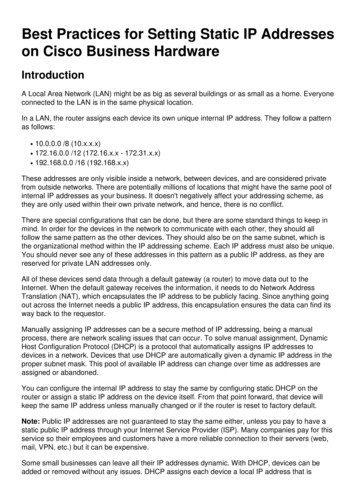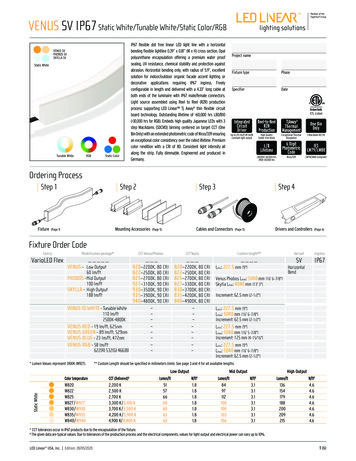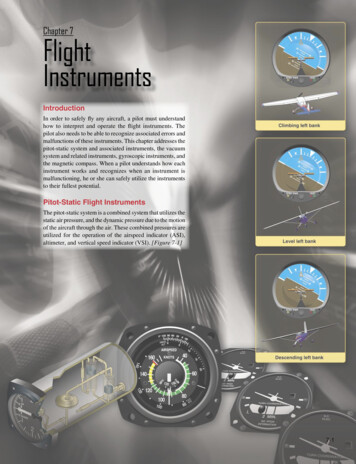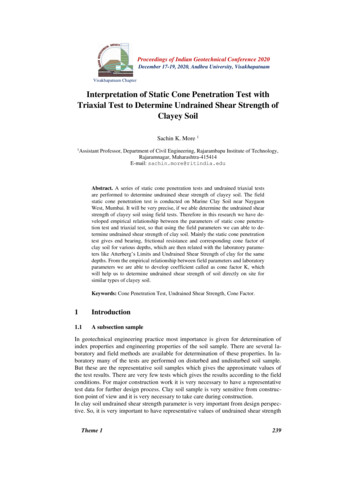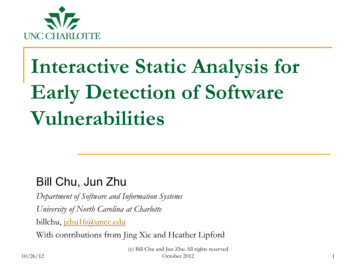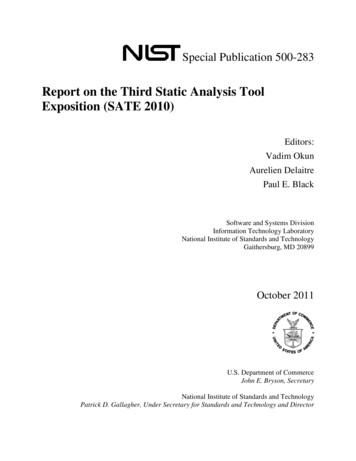
Transcription
Special Publication 500-283Report on the Third Static Analysis ToolExposition (SATE 2010)Editors:Vadim OkunAurelien DelaitrePaul E. BlackSoftware and Systems DivisionInformation Technology LaboratoryNational Institute of Standards and TechnologyGaithersburg, MD 20899October 2011U.S. Department of CommerceJohn E. Bryson, SecretaryNational Institute of Standards and TechnologyPatrick D. Gallagher, Under Secretary for Standards and Technology and Director
Abstract:The NIST Software Assurance Metrics And Tool Evaluation (SAMATE) projectconducted the third Static Analysis Tool Exposition (SATE) in 2010 to advance researchin static analysis tools that find security defects in source code. The main goals of SATEwere to enable empirical research based on large test sets, encourage improvements totools, and promote broader and more rapid adoption of tools by objectivelydemonstrating their use on production software.Briefly, participating tool makers ran their tool on a set of programs. Researchers led byNIST performed a partial analysis of tool reports. The results and experiences werereported at the SATE 2010 Workshop in Gaithersburg, MD, in October, 2010. The toolreports and analysis were made publicly available in 2011.This special publication consists of the following three papers. “The Third StaticAnalysis Tool Exposition (SATE 2010),” by Vadim Okun, Aurelien Delaitre, and Paul E.Black, describes the SATE procedure and provides observations based on the datacollected. The other two papers are written by participating tool makers.“Goanna Static Analysis at the NIST Static Analysis Tool Exposition,” by Mark Bradley,Ansgar Fehnker, Ralf Huuck, and Paul Steckler, introduces Goanna, which uses acombination of static analysis with model checking, and describes its SATE experience,tool results, and some of the lessons learned in the process.Serguei A. Mokhov introduces a machine learning approach to static analysis andpresents MARFCAT’s SATE 2010 results in “The use of machine learning with signaland NLP processing of source code to fingerprint, detect, and classify vulnerabilities andweaknesses with MARFCAT.”Keywords:Software security; static analysis tools; security weaknesses; vulnerabilityCertain instruments, software, materials, and organizations are identified in this paper tospecify the exposition adequately. Such identification is not intended to implyrecommendation or endorsement by NIST, nor is it intended to imply that theinstruments, software, or materials are necessarily the best available for the purpose.NIST SP 500-2832
Table of ContentsThe Third Static Analysis Tool Exposition (SATE 2010) . . 4Vadim Okun, Aurelien Delaitre, and Paul E. BlackGoanna Static Analysis at the NIST Static Analysis Tool Exposition . .41Mark Bradley, Ansgar Fehnker, Ralf Huuck, and Paul StecklerThe use of machine learning with signal- and NLP processing of source code to fingerprint,detect, and classify vulnerabilities and weaknesses with MARFCAT . .49Serguei A. MokhovNIST SP 500-2833
The Third Static Analysis Tool Exposition (SATE 2010)Vadim OkunAurelien DelaitrePaul E. Black{vadim.okun, aurelien.delaitre, paul.black}@nist.govNational Institute of Standards and TechnologyGaithersburg, MD 20899AbstractThe NIST Software Assurance Metrics And Tool Evaluation (SAMATE) project conducted thethird Static Analysis Tool Exposition (SATE) in 2010 to advance research in static analysis toolsthat find security defects in source code. The main goals of SATE were to enable empiricalresearch based on large test sets, encourage improvements to tools, and promote broader andmore rapid adoption of tools by objectively demonstrating their use on production software.Briefly, participating tool makers ran their tool on a set of programs. Researchers led by NISTperformed a partial analysis of tool reports. The results and experiences were reported at theSATE 2010 Workshop in Gaithersburg, MD, in October, 2010. The tool reports and analysiswere made publicly available in 2011.This paper describes the SATE procedure and provides our observations based on the datacollected. We improved the procedure based on lessons learned from our experience withprevious SATEs. One improvement was selecting programs based on entries in the CommonVulnerabilities and Exposures (CVE) dataset. Other improvements were selection of toolwarnings that identify the CVE entries, expanding the C track to a C/C track, having larger —up to 4 million lines of code — test cases, clarifying further the analysis categories, and havingmuch more detailed analysis criteria.This paper identifies several ways in which the released data and analysis are useful. First, theoutput from running many tools on production software can be used for empirical research.Second, the analysis of tool reports indicates actual weaknesses that exist in the software and thatare reported by the tools.Third, the CVE-selected test cases contain real-life exploitable vulnerabilities, with additionalinformation about the CVE entries, including their locations in the code. These test cases canserve as a challenge to practitioners and researchers to improve existing tools and devise newtechniques. Finally, the analysis may be used as a basis for a further study of the weaknesses inthe code and of static analysis.DisclaimerCertain instruments, software, materials, and organizations are identified in this paper to specifythe exposition adequately. Such identification is not intended to imply recommendation orendorsement by NIST, nor is it intended to imply that the instruments, software, or materials arenecessarily the best available for the purpose.NIST SP 500-2834
Cautions on Interpreting and Using the SATE DataSATE 2010, as well as its predecessors, taught us many valuable lessons. Most importantly, ouranalysis should NOT be used as a basis for rating or choosing tools; this was never the goal ofSATE.There is no single metric or set of metrics that is considered by the research community toindicate or quantify all aspects of tool performance. We caution readers not to apply unjustifiedmetrics based on the SATE data.Due to the variety and different nature of security weaknesses, defining clear and comprehensiveanalysis criteria is difficult. While the analysis criteria have been much improved since theprevious SATEs, further refinements are necessary.The test data and analysis procedure employed have limitations and might not indicate how thesetools perform in practice. The results may not generalize to other software because the choice oftest cases, as well as the size of test cases, can greatly influence tool performance. Also, weanalyzed a small subset of tool warnings.In SATE 2010, we added CVE-selected programs to the test sets for the first time. The procedurethat was used for finding CVE locations in code and selecting tool warnings related to the CVEshas limitations, so the results may not indicate tools’ ability to find important securityweaknesses.The tools were used in this exposition differently from their use in practice. We analyzed toolwarnings for correctness and looked for related warnings from other tools, whereas developersuse tools to determine what changes need to be made to software, and auditors look for evidenceof assurance. Also in practice, users write special rules, suppress false positives, and write codein certain ways to minimize tool warnings.We did not consider the user interface, integration with the development environment, and manyother aspects of the tools, which are important for a user to efficiently and correctly understand aweakness report.Teams ran their tools against the test sets in July 2010. The tools continue to progress rapidly, sosome observations from the SATE data may already be out of date.Because of the stated limitations, SATE should not be interpreted as a tool testing exercise. Theresults should not be used to make conclusions regarding which tools are best for a particularapplication or the general benefit of using static analysis tools. In Section 4 we suggestappropriate uses of the SATE data.NIST SP 500-2835
1IntroductionSATE 2010 was the third in a series of static analysis tool expositions. It was designed toadvance research in static analysis tools that find security-relevant defects in source code.Briefly, participating tool makers ran their tool on a set of programs. Researchers led by NISTperformed a partial analysis of test cases and tool reports. The results and experiences werereported at the SATE 2010 Workshop [26]. The tool reports and analysis were made publiclyavailable in 2011. SATE had these goals: To enable empirical research based on large test setsTo encourage improvement of toolsTo foster adoption of tools by objectively demonstrating their use on production softwareOur goal was neither to evaluate nor choose the "best" tools.SATE was aimed at exploring the following characteristics of tools: relevance of warnings tosecurity, their correctness, and prioritization. We based SATE analysis on the textual reportsproduced by tools — not their user interfaces — which limited our ability to understand theweakness reports.SATE focused on static analysis tools that examine source code to detect and report weaknessesthat can lead to security vulnerabilities. Tools that examine other artifacts, like requirements, andtools that dynamically execute code were not included.SATE was organized and led by the NIST Software Assurance Metrics And Tool Evaluation(SAMATE) team [21]. The tool reports were analyzed by a small group of analysts, consisting ofthe NIST researchers and a volunteer. The supporting infrastructure for analysis was developedby the NIST researchers. Since the authors of this report were among the organizers and theanalysts, we sometimes use the first person plural (we) to refer to analyst or organizer actions.Security experts from Cigital performed time-limited analysis for 2 test cases.1.1TerminologyIn this paper, we use the following terminology. A vulnerability is a property of system securityrequirements, design, implementation, or operation that could be accidentally triggered orintentionally exploited and result in a security failure [24]. A vulnerability is the result of one ormore weaknesses in requirements, design, implementation, or operation.A warning is an issue (usually, a weakness) identified by a tool. A (tool) report is the outputfrom a single run of a tool on a test case. A tool report consists of warnings. Many weaknessescan be described using source-to-sink paths. A source is where user input can enter a program. Asink is where the input is used.1.2Previous SATE ExperienceWe planned SATE 2010 based on our experience from SATE 2008 [27] and SATE 2009 [30].The large number of tool warnings and the lack of the ground truth complicated the analysis taskin SATE. To address this problem in SATE 2009, we selected a random subset of tool warningsand tool warnings related to findings by security experts for analysis. We found that whilehuman analysis is best for some types of weaknesses, such as authorization issues, tools findNIST SP 500-2836
weaknesses in many important weakness categories and can quickly identify and describe indetail many weakness instances.In SATE 2010, we included an additional approach to this problem – CVE-selected test cases.Common Vulnerabilities and Exposures (CVE) [5] is a database of publicly reported securityvulnerabilities. The CVE-selected test cases are pairs of programs: an older, vulnerable versionwith publicly reported vulnerabilities (CVEs) and a fixed version, that is, a newer version wheresome or all of the CVEs were fixed. For the CVE-selected test cases, we focused on toolwarnings that correspond with the CVEs.We also found that the tools’ philosophies about static analysis and reporting were often verydifferent, which is one reason they produced substantially different warnings. While tools oftenlook for different types of weaknesses and the number of warnings varies widely by tool, there isa higher degree of overlap among tools for some well known weakness categories, such as buffererrors. More fundamentally, the SATE experience suggested that the notion that weaknessesoccur as distinct, separate instances is not reasonable in most cases.A simple weakness can be attributed to one or two specific statements and associated with aspecific Common Weakness Enumeration (CWE) [3] entry. In contrast, a non-simple weaknesshas one or more of these properties: Associated with more than one CWE (e.g., chains and composites [4]).Attributed to many different statements.Has intermingled flows.In [27], we estimated that only between 1/8 and 1/3 of all weaknesses are simple weaknesses.We found that the tool interface was important in understanding most weaknesses – a simpleformat with line numbers and little additional information did not always provide sufficientcontext for a user to efficiently and correctly understand a weakness report. Also, a binarytrue/false positive verdict on tool warnings did not provide adequate resolution to communicatethe relation of the warning to the underlying weakness. We expanded the number of correctnesscategories to four in SATE 2009 and five in SATE 2010: true security, true quality, true butinsignificant, unknown, and false. At the same time, we improved the warning analysis criteria.1.3Related WorkMany researchers have studied static analysis tools and collected test sets. Among these, Zhenget. al [37] analyzed the effectiveness of static analysis tools by looking at test and customerreported failures for three large-scale network service software systems. They concluded thatstatic analysis tools are effective at identifying code-level defects. Also, SATE 2008 found thattools can help find weaknesses in most of the SANS/CWE Top 25 [23] weakness categories [27].Several collections of test cases with known security flaws are available [12] [38] [15] [22].Several assessments of open-source projects by static analysis tools have been reported recently[1] [9] [10]. Walden et al. [33] measured the effect of code complexity on the quality of staticanalysis. For each of the 35 format string vulnerabilities that they selected, they analyzed boththe vulnerable and the fixed version of the software. We took a similar approach with the CVEselected test cases. Walden et al. [33] concluded that successful detection rates of format stringvulnerabilities decreased with an increase in code size or code complexity.NIST SP 500-2837
Kupsch and Miller [13] evaluated the effectiveness of static analysis tools by comparing theirresults with the results of an in-depth manual vulnerability assessment. Of the vulnerabilitiesfound by manual assessment, the tools found simple implementation bugs, but did not find anyof the vulnerabilities requiring a deep understanding of the code or design.National Security Agency’s Center for Assured Software [36] ran 9 tools on over 59 000synthetic test cases covering 177 CWEs and found that static analysis tools differed significantlyin precision and recall, and their precision and recall ordering varied for different weaknesses.They concluded that the sophisticated use of multiple tools would increase the rate of findingweaknesses and decrease the false positive rate.A number of studies have compared different static analysis tools for finding security defects,e.g., [8] [12] [16] [20] [38] [11]. SATE was different in that many teams ran their own tools on aset of open source programs. Also, the objective of SATE was to accumulate test data, not tocompare tools.The rest of the paper is organized as follows. Section 2 describes the SATE 2010 procedure andsummarizes the changes from the previous SATEs. Since we made a few changes andclarifications to the SATE procedure after it started (adjusting the deadlines and clarifying therequirements), Section 2 describes the procedure in its final form. Section 3 gives ourobservations based on the data collected. Section 4 provides summary and conclusions, andSection 5 lists some future plans.2SATE OrganizationThe exposition had two language tracks: a C/C track and a Java track. At the time ofregistration, teams specified which track(s) they wished to enter. We performed separate analysisand reporting for each track. Also at the time of registration, teams specified the version of thetool that they intended to run on the test set(s). We required teams to use a version of the toolhaving a release or build date that was earlier than the date when they received the test set(s).2.1Steps in the SATE procedureThe following summarizes the steps in the SATE procedure. Deadlines are given in parentheses. Step 1 Prepareo Step 1a Organizers choose test setso Step 1b Teams sign up to participate (by 25 June 2010)Step 2 Organizers provide test sets via SATE web site (28 June 2010)Step 3 Teams run their tool on the test set(s) and return their report(s) (by 30 July 2010)Step 4 Organizers analyze the reports, provide the analysis to the teams (preliminaryanalysis by 14 Sep 2010, updated analysis by 22 Sep 2010)o Organizers select a subset of tool warnings for analysis and share with the teams(by 24 Aug 2010)o (Optional) Teams check their tool reports for matches to the CVE-selected testcases and return their review (by 1 Sep 2010)o (Optional) Teams return their review of the selected warnings from their tool'sreports (by 8 Sep 2010)Step 5 Report comparisons at SATE 2010 workshop [26] (1 Oct 2010)NIST SP 500-2838
2.2Step 6 Publish results 1 (Originally planned for Feb - May, but delayed until Oct 2011)Test SetsThis Section lists the test cases we selected, along with some statistics for each test case, in Table1. The last two columns give the number of files and the number of non-blank, non-commentlines of code (LOC) for the test cases. The lines of code and files were counted before buildingthe programs. For several test cases, counting after the build process would have produced highernumbers. For each CVE-selected test case, the table has separate rows for the vulnerable andfixed versions.The counts for C and C test cases include C/C source (e.g., .c, .cpp, .objc) and header (.h)files. Dovecot and Wireshark are C programs, whereas Chrome is a C program. The countsfor Dovecot include 2 C files. The counts for the Java test cases include Java (.java) and JSP(.jsp) files. Pebble’s test code (in src/test subdirectory) is not included in its counts. Tomcat ver.5.5.13 includes 192 C files. Tomcat ver. 5.5.29 does not include any C files. The C files were notincluded in the counts for Tomcat. The counts do not include source files of other types: makefiles, shell scripts, Assembler, Perl, PHP, and SQL.Mitigation for Cross-Site Request Forgery (CSRF) CWE-352 was introduced in the version ofPebble that was analyzed by tools. However, an implementation bug in CSRF mitigation codeprevented many features of Pebble from working properly. Security experts analyzed, as part ofSATE 2010, a newer build of Pebble, where the only change was removal of CSRF mitigationcode. The expert analysis is described in Section 2.6.1, Method 2.The lines of code and files were counted using SLOCCount by David A. Wheeler [35].Test caseTrackDescriptionVersionDovecotWiresharkC/C Secure IMAP and POP3 serverNetwork protocol analyzer2.0 Beta 61.2.01.2.95.0.375.545.0.375.702.5 M25.5.135.5.29GoogleChromePebbleApacheTomcatWeb browserJavaWeblog softwareServlet container# Files11112281227819 07019 07060314941603# LOC193 5011 625 3961 630 2823 958 8613 958 99829 422180 966197 060Table 1 Test casesThe links to the test case developer web sites, as well as links to download the versions analyzed,are available at the SATE web page [28].We spent several weeks selecting the test cases and considered dozens of candidates. Inparticular, we looked for test cases with various security defects, over 10 000 lines of code, andcompilable using a commonly available compiler. We used different selection criteria andselection process for the CVE-based test cases and the general test cases. The following sectiondescribes how we selected the CVE-based test cases.1Per requests by Coverity and Grammatech, their tool output is not released as part of SATE data. Consequently,our detailed analysis of their tool warnings is not released either. However, the observations and summary analysisin this paper are based on the complete data set.NIST SP 500-2839
2.3CVE-Selected Test CasesIn addition to the criteria listed above, we used the following selection criteria for the CVE-basedtest cases and also for selecting the specific versions of the test cases. Program had several, preferably dozens, of vulnerabilities reported in the CVE database.We were able to find the source code for a version of the test case with CVEs present(vulnerable version).We were able to identify the location of some or all CVEs in the vulnerable version.We were able to find a newer version where some or all CVEs were fixed (fixed version).Reliable resources, such as bug databases and source code repositories, were available forlocating the CVEs.Both vulnerable and fixed versions were available for Linux OS.Many CVEs were in the vulnerable version, but not in the fixed versions.Both versions had similar design and directory structure.There is a tradeoff between the last two items. Having many CVEs fixed between the vulnerableand fixed versions increased the chance of a substantial redesign between the versions.We used the following sources of information in selecting the test cases and identifying theCVEs. First, we exchanged ideas within the NIST SAMATE team and with other researchers.Second, we used several lists to search for open source programs [25] [18] [1] [10]. Third, weused several public vulnerability databases [5] [7] [17] [19] to identify the CVEs.The selection process for the CVE-based test cases included the following steps. The processwas iterative, and we adjusted it in progress. Identify potential test cases – popular open source software written in C, C or Java andlikely to have vulnerabilities reported in CVE.Collect a list of CVEs for each program.For each CVE, collect several factors, including CVE description, versions where theCVE, weakness type (or CWE if available), version where the CVE is fixed, and patch.Choose a smaller number of test cases that best satisfy the above selection criteria.For each CVE, find where in the code it is located.We used the following sources to identify the CWE ids for the CVE entries. First, NationalVulnerability Database (NVD) [17] entries often contain CWE ids. Second, for some CWEentries, there is a section “Observed Examples” with links to CVE entries. Two CVE entriesfrom SATE 2010 occurred as Observed Examples: CVE-2010-2299 for CWE-822 and CVE2008-0128 for CWE-614. Finally, we sometimes assigned the CWE ids as a result of a manualreview.Locating a CVE in the code is necessary for finding related warnings from tools. Since a CVElocation can be either a single statement or a block of code, we recorded the block length in linesof code. If a warning refers to any statement within the block of code, it may be related to theCVE.As we noted in Section 1, a weakness can often be located on a path, so it cannot be attributed toa single line of code. Also, sometimes a weakness can be fixed in a different part of code.Accordingly, we attempted to find three kinds of locations:NIST SP 500-28310
Fix – a location where the code has been fixed,Sink – location where user input is used, andPath – location that is part of the path leading to the sink.The following example, a simplified version of CVE-2009-3243 in Wireshark, demonstrates thedifferent kinds of locations. The statements are far apart in the code.// Index of the missing array element#define SSL VER TLSv1DOT27const gchar* ssl version short names[] ","PCT",// Fix: the following array element was missing in the vulnerable version "TLSv1.2"};// Path: may point to SSL VER TLSv1DOT2conv version &ssl session- version;// Sink: Array overrunssl version short names[*conv version]Since the CVE information is often incomplete, we used several approaches to find CVElocations in code. First, we searched the CVE description and references for relevant file orfunction names. Second, we reviewed program’s bug tracking, patch, and version control loginformation, available online. We also reviewed relevant vulnerability notices from Linuxdistributions that included these programs. Third, we used the file comparison utility “diff” tocompare the corresponding source files in the last version with a CVE present and the firstversion where the CVE was fixed. This comparison often showed the fix locations. Finally, wemanually reviewed the source code.Some of the information links, such as which bug ID in the bug database corresponds to theCVE, were missing. We reviewed change logs and used other hints to find the CVE locations.The following is one scenario for pinpointing the CVE in code. First, view a CVE entry in theNVD. Second, follow a link to the corresponding bug description in the program’s bug database.Third, from the bug description, find the program’s revision where the bug was fixed. Fourth, foreach source file that was changed in the revision, examine the patch, that is, the difference withthe previous version of the file. The patch often contains the fix location. Finally, examine thesource code to find the corresponding sink and/or path locations.2.4ToolsTable 2 lists, alphabetically, the tools and the tracks in which the tools were applied.One of the teams, Veracode, is a service. Its tool is not available publicly. Veracode performed ahuman quality review of its reports to remove spurious warnings such as high false positives in aparticular weakness category. This quality review is part of its usual analysis procedure.NIST SP 500-28311
ToolArmorize CodeSecureConcordia University MARFCAT 2Coverity Static Analysis for C/C 3CppcheckGrammatech CodeSonar 45LDRA Testbed 6Red Lizard Software GoannaSeoul National University Sparrow 7SofCheck Inspector for Java 8Veracode SecurityReview 9Version4.0.0.2SATE2010.65.2.11.433.6 (build 59634)8.3.02.01.02.22510As of 07/12/2010TracksJavaC/C , JavaC/C C/C C/C C/C C/C C/C JavaC/C , JavaTable 2 Tools2.5Tool Runs and SubmissionsTeams ran their tools and submitted reports following these specified conditions. Teams did not modify the code of the test cases.For each test case, teams did one or more runs and submitted the report(s). See below formore details.Except for Veracode, the teams did not do any hand editing of tool reports. Veracode, aservice, performed a human quality review of its reports to remove spurious warningssuch as high false positives in a particular weakness category. This quality review didnot add any results.Teams converted the reports to a common XML format. See Section 2.8.1 for descriptionof the format.Teams specified the environment (including the operating system and version ofcompiler) in which they ran the tool. These details can be found in the SATE tool reportsavailable at [28].Most teams submitted one tool report per test case for the track(s) that they participated in.LDRA and Grammatech analyzed Dovecot only. Sparrow works on C only, so it was run onDovecot and Wireshark, but not on Chrome. Sparrow was run with an option which lets itdistinguish up to two array elements, whereas in default configuration, array elements arecombined into a single abstract location.SofCheck analyzed Pebble only. SofCheck Inspector was run in default mode, which did notinclude its checks for XSS and SQL injection weaknesses.Coverity and Grammatech tools were configured to improve analysis of Dovecot’s custommemory functions. See “Special case of Dovecot memory management” in Section 2.7.4.2Marfcat was in early stages of development; reports were submitted late; we did not analyze the reportsPer Coverity's request, Coverity tool output is not released as part of SATE data4Analyzed Dovecot only5Per Grammatech’s request, Grammatech tool output is not released as part of SATE data6Analyzed Dovecot only7Sparrow works on C only, so analyzed Dovecot and Wireshark8Analyzed Pebble only9A service3NIST SP 500-28312
Whenever tool runs were tuned, e.g., with configuration options, the tuning details were includedin the teams’ submissions.MARFCAT was in the early stages of development during SATE 2010, so the reports weresubmitted late. As a result, we did not analyze the output from any of MARFCAT reports.Serguei Mokhov described MARFCAT methodology and results in “The use of machinelearning with signal- and NLP processing of source code to fingerprint, detect, and classifyvulnerabilities and weaknesses with MARFCAT,” included in this publication.In all, we analyzed the output from 32 tool runs. This counts tool outputs for vulnerable andfixed versions of the same CVE-based program separately.Several teams also submitted the original reports from their tools, in addition to the reports in theSATE output format. During our analysis, we used some of the information, such as details ofweakness paths, from some of the original reports to better understand the warnings.Several tools (Grammatech CodeSonar, Coverity Static Analysis, and LDRA Testbed) did notassign severity to the warnings. For example, Grammatech CodeSonar uses rank (a combinationof severity and likelihood) instead of severity. All warnings in their submitted reports hadseverity 1. We changed the severity field for some warning classes in the GrammatechCodeSonar, Coverity Static Analysis, and LDRA Testbed reports based on the weakness namesand some additional information from the tools.After the analysis step of the SATE protocol (Section 2.1) wa
conducted the third Static Analysis Tool Exposition (SATE) in 2010 to advance research in static analysis tools that find security defects in source code. The main goals of SATE were to enable empirical research based on large test sets, encourage improvements to tools, and promote broader and more rapid adoption of tools by objectively


